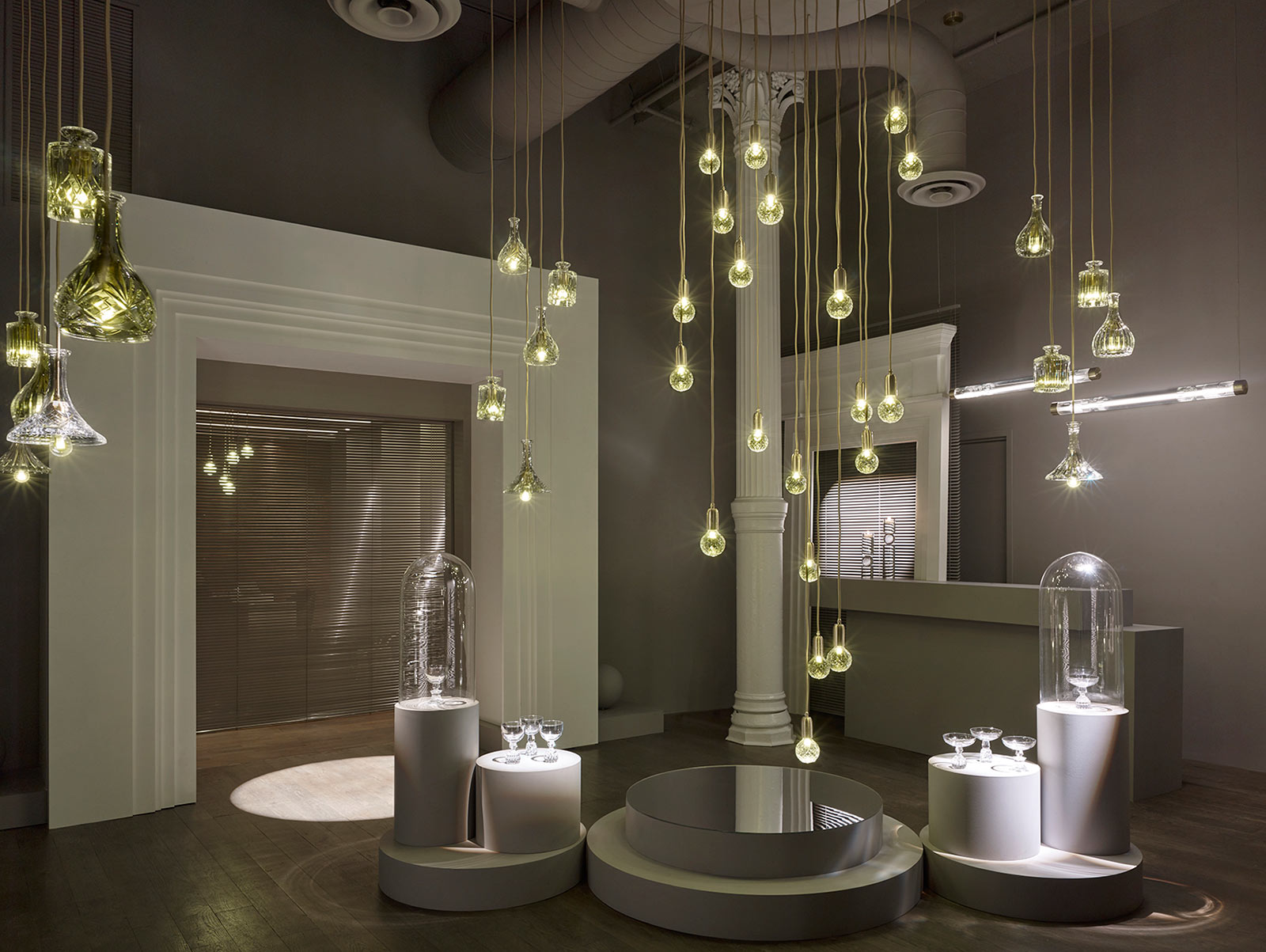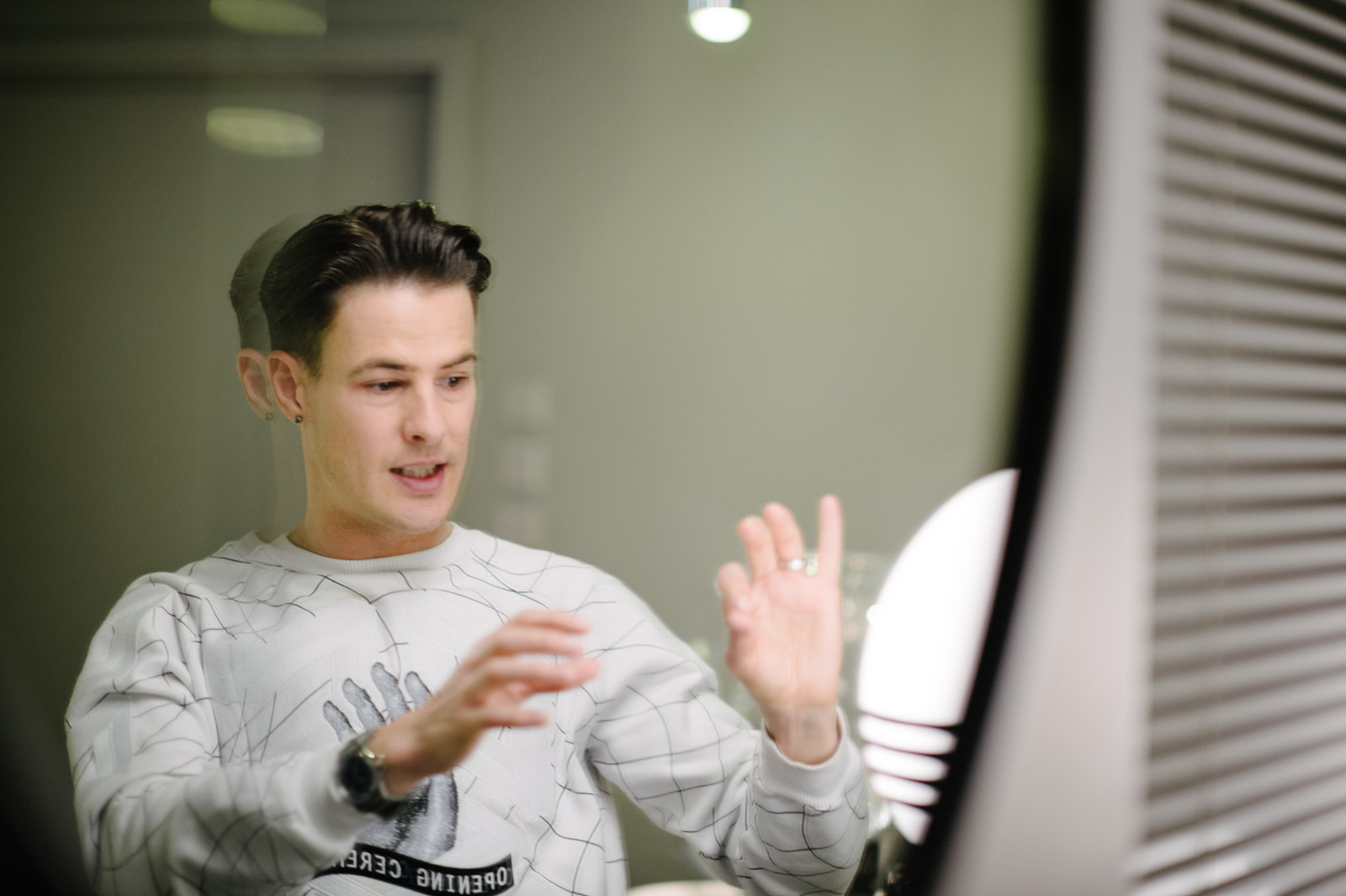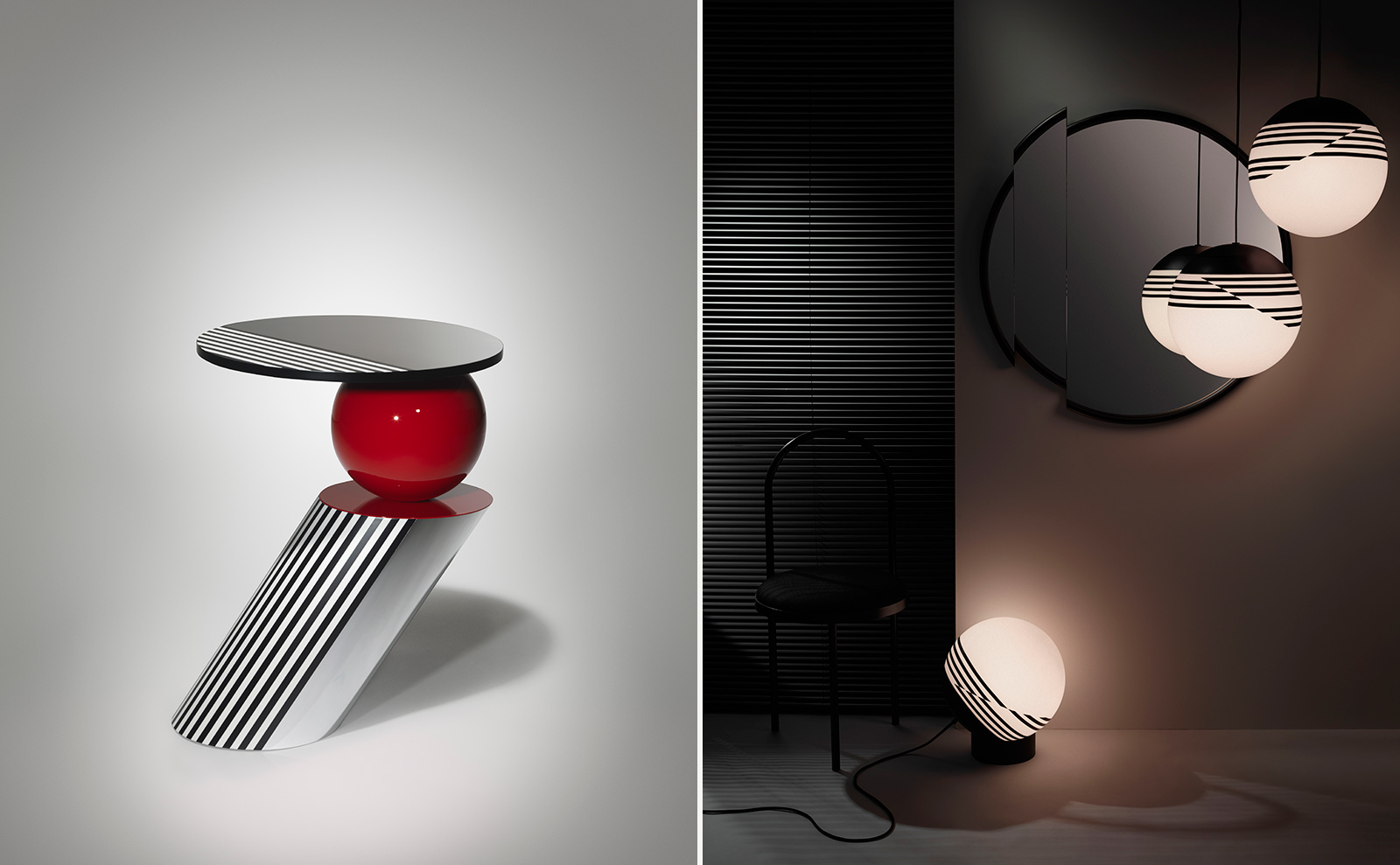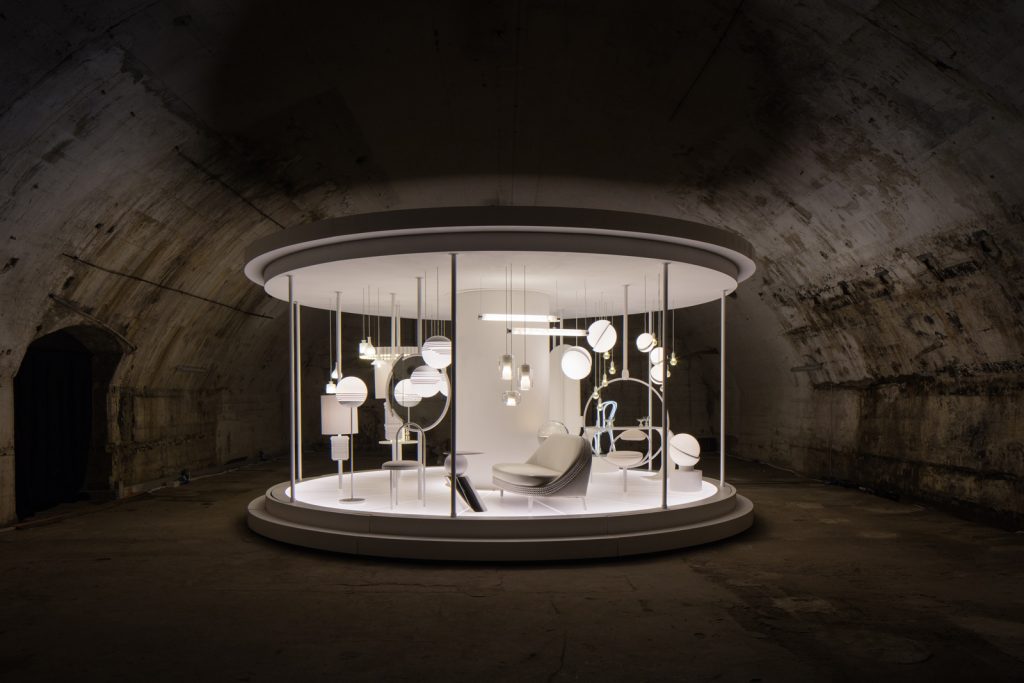Interview: Lee Broom
At his NYC pop-up shop, the British designer shares his path to success and creative expression

Built upon the pillars of crystal, marble, brass and glass, the sophisticated world of luxury design can sometimes be fatiguing, and a little “seen that, done that.” But Lee Broom is a good storyteller beyond just the creative pieces he makes—from “drunken” side tables to chapel lighting, an acid-etched marble coffee table, crystal light bulbs and a tube that looks like a fluorescent light but actually is milled from Carrara marble. Last September during London Design Festival, the British designer created a temporary flower shop to showcase his first-ever collection of vases. He opened a grey-toned department store last year for Milan Design Week; this year, he created a mini palazzo inside a delivery van for his lighting collection, driving the “Salone del Automobile” around the neighborhoods participating in design week.

He recently set up his first pop-up in New York for NYCxDesign Week. The “Broom off Broome” shop, featuring around 50 of his furniture and home decor pieces (all available for sale) will come to a close on 10 June, but just before that Cool Hunting is hosting the closing party next Tuesday, 7 June 2016 from 6-8PM. We met Broom at the space, 63 Greene Street, to learn how the former actor and fashion designer established himself as a force of modern British design.

When did you know you were a designer?
Like as soon as I saw that I could draw—seven, eight? My dad owned a printing factory but he was a very good amateur artist, a draftsman. I remember him teaching me the techniques you could use to draw, and I would draw every night at home in my bedroom. I would mainly draw apartment blocks, shopping malls, cities. Sometimes I’d do the interiors that I would imagine I would be living in my 20s. I loved opulence but I loved modernist design as well. You can kind of see that in my work now.
I was also into fashion. I was obsessed with designers like Vivienne Westwood, Gianni Versace, Gaultier—so I would always be sketching. That’s how I ended up going into fashion. I won a Young Designer of the Year award which was judged by Vivienne Westwood when I was 17. That’s how I got to work with her; I asked her for her autograph and she wrote her phone number down at the after-show awards.The plan was always for me to be in an actor in my adulthood. But I had a real interest in design and art—and when I was 17, I entered this competition because ‘I love her so much, I know I can do it.’ But I didn’t expect to win!
She invited me to the studio for two days. It was amazing. It was just me and her for two days. She taught me how she approached pattern-cutting, the artists she was into, literature that she loved, how she didn’t want to be a fashion designer and fell into it. I was just soaking everything up. And I had a book of like 100 outfits that I had sketched, and I showed her and her husband Andreas at the end of the two days. And she was like, “Well you can stay as an intern if you want. We can’t pay you but you can work in the studio and pattern-cutting room.” So I ended up staying there for 10 months…
Then I went back to the Midlands, back where I was from, and was like, “OK, I’m not going to be an actor anymore, I’m going to be a fashion designer!” My parents were kind of, “Ugh!” because they had invested so much. But it was a big deal [to work at] Westwood and they could see that. And I ended up going to Central Saint Martins. Interestingly, Vivienne discouraged me from going to fashion school. She was like, “They’ll homogenize you and teach you how to think. You can do this on your own; you don’t need to be put in that box.” But I felt like it was a different time from when she started and I needed that training.

You studied theater and fashion. How did that evolve to furniture?
In my final year at Saint Martins, I was so sick of working at bars and clubs and wanted to work for myself. And I’d been decorating my apartment. I used to make these hideous mirror frames, plaster and fabric and gold leaf—very of that time. I used to go to bars and restaurants, try to sell these mirror frames and say, “I could do bits of upholstery, I could make some curtains for you.” And it kind of grew into this tiny little business and I started making money. Then one of the bar owners asked me to design a venue from scratch.
It was like a 25,000 square feet venue; it was a club, a bar and a restaurant right in the center of the Financial District in London. They spent three-quarters of a million pounds on the project. I brought my friend Maki [Aoki], this Japanese girl I was mates with at Saint Martins. Myself and Maki designed and project managed, did the drawings, space planning, colors, we designed furniture pieces for it… It took about nine months to build, and it was like an intensive training course on a live interiors project. On one hand, we didn’t know what we’re doing. But on the other hand, because we had no frame of reference we didn’t really care. It was called Nylon, this was in 2001—so a year after I graduated. It was popular so we started getting offered more work, so I was like, “OK do I want to go into fashion?” I wanted to work for myself, I knew that—I didn’t want to work for anybody else. Going into fashion required me getting a whole load of investment, making samples, getting a collection together. Or do I go into this business where it’s service-led, it’s not going to require as much start-up cost and I’ve been offered work already. And the main thing was, my creative vision was being put into practice. So we set up a company called Makilee and we did that for four years; we designed bars and restaurants in London. And in 2007, Maki moved back to Japan and I decided I wanted to start Lee Broom but [focus on] furniture and lighting. We designed bespoke furniture pieces for venues that we were doing—we always wanted to put one of our own pieces in, somehow—so I’d built up a network of manufacturers in the UK that I’d worked with, saved the money I’d been getting from various projects. We did a really nice big project towards the end before she left, and I basically invested all of that money into Lee Broom. We did our neon lighting collection, and that was the first collection. Since then, it’s been two collections every year.

Your marble tube lights are incredibly elegant, technically complicated, but also really sculptural. You have a lot of multi-disciplinary talent. And the objects have character beyond the design of the piece. Within the context of a room, it speaks in a way that’s different, bigger, more grand. Which you also mention, this sense of “opulence.” A lot of those pieces bring a level of opulence to them that’s modern, clean, simple. Different than I think, traditionally when you think of opulent, it’s incredibly ornate.
Some people describe my work as “glamorous” which I really hate, because I find that to be a crass word. At the same time, I kind of like that border line between crassness and taste. That marble collection, I call Nouveau Rebel because marble when I was growing up felt very nouveau riche: a tacky, opulent material. Now it has a reputation for being honest, natural material. So I like the idea of nouveau riche, nouveau rebel—changing that up a bit without forgetting that it went through that period. Opulence is kind of using material that is opulent and putting it into something that’s sculptural, contemporary. That [Tube] piece is reflective of a classic, ugly fluorescent tube that we’re all used to seeing in garages, warehouses. But to create exactly the same light fixture in a very luxury, handcrafted material appeals to me.
Some people describe my work as “glamorous” which I really hate, because I find that to be a crass word. At the same time, I kind of like that border line between crassness and taste.
Even the Crescent light—it’s taking the very classic Art Deco globe that we all know, and slicing it in a simple way, shifting it to make it very modern. There’s opulence, there’s modernism, there’s taking things you’ve seen before and presenting them in a different way. That’s maybe one of the reason why our products are successful, that they are popular, they do sell. Because when people see them, they have a familiarity with them already. They already have a relationship with that product because they feel like they’ve seen it before, but not quite.

Hearing you talk about your past in theater, fashion, when you look at what you’ve done to present your collections—like the mobile showroom in a truck—it’s incredibly different than what everyone else is doing. Here in New York, you have a pop-up that doesn’t even feel like a pop-up; it feels like a very established storefront. All of these things come into play with the presentation of your work, which is really interesting.
It definitely stems from my background in theater. Subconsciously it’s there all the time, the idea of seeing everything as a performance. All the work that you present is like a show. I remember being in Saint Martins and really, really struggling financially but I would put every single last penny into the presentations into a critique—hundreds of pounds—and not have too much to eat the next week. And we haven’t changed, actually. [laughs] It’s just on a bigger scale. I remember being frustrated when I started Lee Broom; I had all these ideas but didn’t have the budgets to be able to execute what I wanted. We don’t always need massive budgets, either. The main thing is, my theater background has enabled me to see things as a performance. Especially in Milan, it’s such a stressful environment to be around. And it’s nice to take them out of the ordinary and take them into the extraordinary.

I think you stole the show doing something that was really unexpected, that represented you and your brand really well—that moved around town! It was incredibly clever and newsworthy, yet also presented your product in a good way. When you think of the money you would have spent on a booth I think this was a much better investment.
The year before, we obviously did a really big show. I’m really conscious of when you present big—there’s this expectation that every year, you have to outdo yourself. I’m not really interested in that. I like the idea of scaling it right back to something else. Designing something that is very small is a lot more difficult because you have to be a lot more creative in how you’re thinking. And I like the idea of presenting 25 products and the next year, presenting one. It just keeps me more interested, changing it each year. I think more than anything, particularly in Milan, it’s taking people out of the usual, and giving them an immersive journey in some way.
The store in New York is more about presenting all of my pieces in one space, and introducing the brand to a whole bunch of people that maybe might not be familiar with all of my work. The space needed to have less of a narrative, rather than the products.
It didn’t even occur to me to ask this question until we started digging into theater, performance, and your upbringing as an actor—is Lee Broom your real name?
My mother wanted to change it, actually! She wanted me to be called Lee Groom, for some reason…But yeah, that’s my real name. In my logo you’ll see that there’s the crown, and underneath there’s a broom—that was my dad’s signature on his paintings that he used to do.
Portraits by Josh Rubin, store images courtesy of Peter Murdock












